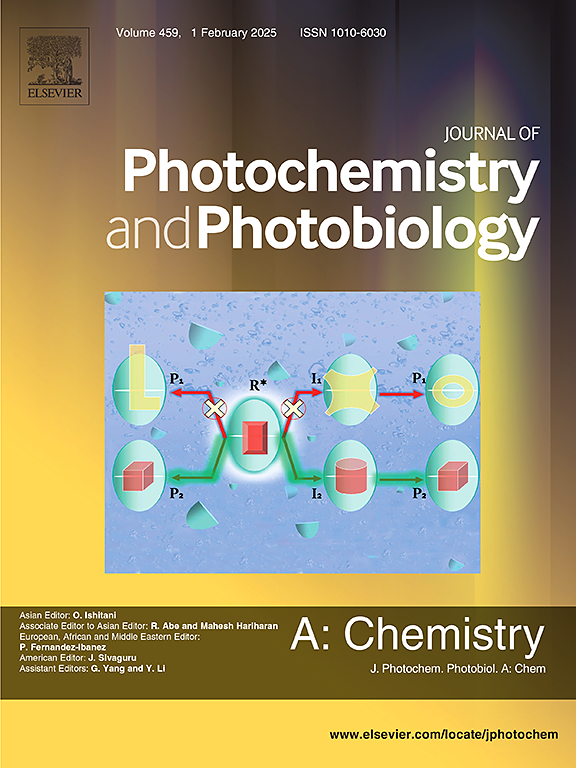Mechanistic insights into the G-quadruplex-duplex equilibrium in the c-kit promoter: Role of ions and flanking sequences
IF 4.1
3区 化学
Q2 CHEMISTRY, PHYSICAL
Journal of Photochemistry and Photobiology A-chemistry
Pub Date : 2025-04-03
DOI:10.1016/j.jphotochem.2025.116424
引用次数: 0
Abstract
Nucleic acid-ion interactions constitute an intrinsic cornerstone of the physicochemical, energetic, and structural attributes of DNA and RNA. These interactions determine the folding and stabilization of intricate secondary and tertiary architectures, such as G-quadruplexes (GQs), which have pivotal functional significance in telomeric regions, origins of replication, and various gene promoter sequences. Earlier studies have elucidated that the 22-mer c-kit promoter sequence adopts a parallel-stranded G-quadruplex conformation, exhibiting a high degree of structural conservation within its duplex and quadruplex form. However, detailed mechanistic insight into this interconversion of these two conformations at single-molecule resolution has not been explored explicitly. In this work we have employed single-molecule FRET experiments (smFRET) to investigate the dynamic interconversion between the usual Watson-Crick duplex structure and the G-quadruplex structure. Herein, we assess the sensitivity of the G quadruplex-duplex equilibrium by introducing a short complementary strand as a pharmacological agent in the presence of Na+/K+ ions. This subtle mechanistic detail of the opening of the quadruplex, because of the hybridization with the complementary strand, reveals that the opening of the K+-stabilised G-quadruplex is slower than the opening of the Na+-stabilised form. smFRET along with CD and ensemble fluorescence measurements demonstrated the ion-mediated effect on the stability and equilibrium of the G-quadruplex and duplex structure. Furthermore, we explored the influence of flanking bases on quadruplex stability and duplex formation in the c-kit promoter region, providing a detailed analysis of how these factors modulate structural transitions.

c-kit启动子中g -四工-双工平衡的机理:离子和侧翼序列的作用
核酸-离子相互作用构成了DNA和RNA的物理化学、能量和结构属性的内在基石。这些相互作用决定了复杂的二级和三级结构的折叠和稳定,例如g -四重结构(GQs),它在端粒区、复制起源和各种基因启动子序列中具有关键的功能意义。早期的研究表明,22-mer c-kit启动子序列采用平行链g -四重构象,在其双链和四重构象中表现出高度的结构保守性。然而,在单分子分辨率下,这两种构象相互转化的详细机制尚未得到明确的探讨。在这项工作中,我们采用单分子FRET实验(smFRET)来研究通常的沃森-克里克双相结构和g -四相结构之间的动态相互转换。在此,我们通过在Na+/K+离子存在下引入短互补链作为药理学剂来评估G四复双平衡的敏感性。由于与互补链的杂交,四重链打开的微妙机理细节揭示了K+稳定的g -四重链的打开比Na+稳定形式的打开慢。smFRET与CD和集合荧光测量表明,离子介导的影响的稳定性和平衡的g -四重和双相结构。此外,我们探索了侧链碱基对c-kit启动子区域四重稳定性和双工形成的影响,并详细分析了这些因素如何调节结构转变。
本文章由计算机程序翻译,如有差异,请以英文原文为准。
求助全文
约1分钟内获得全文
求助全文
来源期刊
CiteScore
7.90
自引率
7.00%
发文量
580
审稿时长
48 days
期刊介绍:
JPPA publishes the results of fundamental studies on all aspects of chemical phenomena induced by interactions between light and molecules/matter of all kinds.
All systems capable of being described at the molecular or integrated multimolecular level are appropriate for the journal. This includes all molecular chemical species as well as biomolecular, supramolecular, polymer and other macromolecular systems, as well as solid state photochemistry. In addition, the journal publishes studies of semiconductor and other photoactive organic and inorganic materials, photocatalysis (organic, inorganic, supramolecular and superconductor).
The scope includes condensed and gas phase photochemistry, as well as synchrotron radiation chemistry. A broad range of processes and techniques in photochemistry are covered such as light induced energy, electron and proton transfer; nonlinear photochemical behavior; mechanistic investigation of photochemical reactions and identification of the products of photochemical reactions; quantum yield determinations and measurements of rate constants for primary and secondary photochemical processes; steady-state and time-resolved emission, ultrafast spectroscopic methods, single molecule spectroscopy, time resolved X-ray diffraction, luminescence microscopy, and scattering spectroscopy applied to photochemistry. Papers in emerging and applied areas such as luminescent sensors, electroluminescence, solar energy conversion, atmospheric photochemistry, environmental remediation, and related photocatalytic chemistry are also welcome.

 求助内容:
求助内容: 应助结果提醒方式:
应助结果提醒方式:


